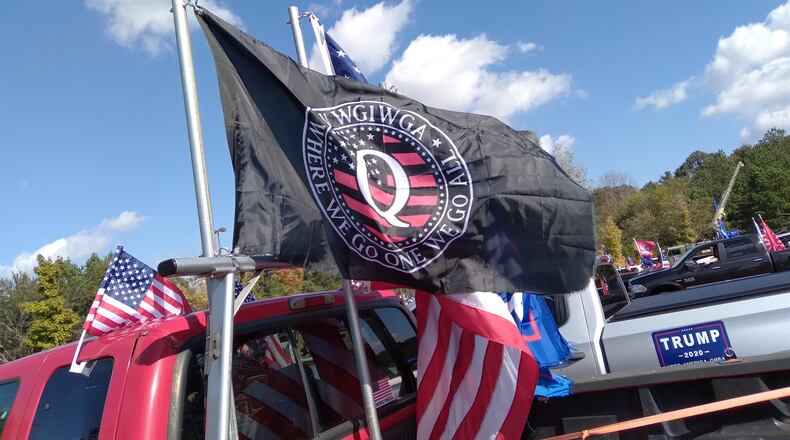Watchdogs and the U.S. intelligence community observed with growing concern as domestic extremist groups rose in prominence in recent years, escalating into a crescendo of chaos and violent outbursts around the presidential election.
They are not going away in 2021, experts told The Atlanta Journal-Constitution.
“Things indeed are escalating,” said Eric Ward, executive director of the Western States Center, a progressive nonprofit that promotes democratic engagement. “We have elected officials who are now being escorted into legislative session by law enforcement because of the level of threats they are experiencing. ... Political violence is going to be part of our reality in 2021.”
Mark Pitcavage, senior research fellow at the Anti-Defamation League’s Center on Extremism, said radical extremist groups may actually grow in 2021 and “find new energy.”
That’s particularly true for movements with an anti-government ideology, like the far-right paramilitary militia movement. Pitcavage said the militia movement has an “odd relationship” with President Trump, admiring him for his outsider demeanor while mistrusting the government he leads.
With Joe Biden in power, that may change, Pitcavage said. “There is a very legitimate chance we could see a resurgence of the militia movement,” he said.
As president, Biden wants to renew the assault weapons ban, expand background checks and ban high-capacity magazines, which have the potential to trigger militia groups.
“With a Biden administration coming in, the militia movement is no longer going to be limited in its anger at the federal government as it has been,” Pitcavage said.
The Proud Boys
If Trump remains a visible force in American politics over the next four years, Pitcavage said fringe right-wing groups could be further energized by his rhetoric.
One such group is the Proud Boys, which gained national notoriety during the first presidential debate when Biden called on Trump to denounce the group. Trump’s cryptic statement to “stand back and stand by” was enthusiastically taken by the group as a presidential endorsement, despite a subsequent rejection by the president on Fox News’s “Hannity.”
Since the election, the Proud Boys have been involved in numerous street demonstrations, including a protest earlier this month in Washington, D.C., that included violent altercations with left-wing counter protesters, and resulted in several stabbings.
The group styles itself as a sardonic “drinking club,” but watchdogs describe it as anti-immigrant, anti-Muslim and deeply misogynistic. The ADL notes that, while not a white supremacist organization itself, some of its leaders have engaged in racist and anti-Semitic rhetoric.
Recently, national leader Enrique Tarrio took part in a protest outside the Capitol in Atlanta after November general election.
“They are one of very few far-right extremist groups that have multiple chapters on the ground across the country,” Pitcavage said.
Whither QAnon?
One of the more perplexing questions of 2021 is what will become of the QAnon conspiracy theory and its adherents. The phenomenon burst into the national consciousness this summer as Facebook scampered to ban fast-growing QAnon groups which organized around coordinated “Save Our Children” marches across the country. One such march in August in Woodstock drew hundreds of marchers.
The QAnon community has long held that Trump is waging a secret war against a globalist cabal of Satanic pedophiles that would culminate in mass arrests of prominent Democrats and celebrities. Alex Newhouse, a researcher with the Center on Terrorism, Extremism, and Counterterrorism at Middlebury College’s Institute of International Studies, said the conspiracy is too robust to fade away, but what shape it will take as Trump exits the White House is unclear.
“There will be some period of turmoil and soul-searching for some of them,” he said. “Some fringe adherence might peel off and lose faith, but the core of the movement will still be there.”
The conspiracy theory may be bolstered by newly elected congresswomen Lauren Boebert of Colorado and Marjorie Taylor Greene of Georgia’s 14th District, both of whom have embraced it. Greene and Boebert will get attention if they choose to push the conspiracy from their new posts in Congress, Newhouse said.
Trump’s potential to spread the conspiracy is a more serious concern. Newhouse said the president remains the central figure in the widening QAnon universe, and that may outlast his presidency.
In the short term, Newhouse said he is concerned about how QAnon adherents will react to Biden’s inauguration.
“There are a lot of far-right groups that are really pushing for physical, real-world accelerationist action,” he said.
Acclerationists are among the most extreme radicals, encouraging violent action to bring about the downfall of the United States as a way to achieve their political goals. If QAnon goes that way, “they become much more dangerous,” Newhouse said.
“If they take that turn, they instantly become the largest right-wing accelerationist group in the world,” he said.
Credit: Alyssa Pointer
Credit: Alyssa Pointer
The radical left
Another trend in 2020 likely to continue in the new year: More guns in the hands of fringe actors.
While far-right groups are more likely to bring weapons to street protests, in the past year more left-wing groups began arming themselves. A militia-led protest in Stone Mountain in August was met with a large number of black-clad counter-protesters armed with assault rifles and sidearms. Groups like the Socialist Rifle Association and the Coalition of Armed Labor advocate carrying weapons to demonstrations for “self-defense.”
Several experts said the development is concerning.
“The first thing we have to do is start the conversation by saying there is no room for political violence in a functioning democracy and it doesn’t matter where it comes from along the political spectrum,” Ward, with the Western States Center, said.
Statements from federal law enforcement and academic studies show armed violence is vastly more likely to come from far-right groups, while leftist groups are more likely to damage property. Ward said there is no equivalence between harming a building and taking a life, but there should be a consensus that neither is acceptable.
“We cannot be so cavalier to believe that property destruction doesn’t have an impact,” he said.
Pitcavage said he anticipated the resurgence of a more radical far left for years.
“What it took was 2020 and the BLM protests, and especially the reaction to the 2020, ... for the left to show up armed,” he said.
Loose collections of radicals who identify as “antifa” have long engaged in brawls with the far-right, but Pitcavage said armed groups are a new feature. But he said it is harder to predict how these groups will develop since they tend to react to unpredictable events like high-profile police shootings.
Hampton Stall, a senior researcher at the Armed Conflict Location & Event Data Project, which monitors political violence around the world, said armed far-left groups likely will remain “reactive” to the activities of the far-right, showing up as a counter-protest force.
“I don’t think that’s going away,” he said. That said, Stall said he does not believe far-left organizing is going to pose the same problems, in part because the politics of the extreme left — communism or anarchism — are even more taboo to American politics than white nationalism.
Leadership needed
Ward, who spent decades in various organizations confronting authoritarian and nationalist groups, said history suggests that such groups may find a fertile recruiting environment in the coming years.
“If we look at the Reagan presidency and the Clinton presidency and Obama’s first term, those were all moments when authoritarian movements were in ascendance,” he said.
Reagan, a racial moderate and staunch anti-communist, was seen as a stealing the steam from fringe groups. Clinton’s presidency and use of executive law enforcement powers angered the burgeoning militia movement. And extremists thrived as Obama’s race, false claims about his birth and his positions on immigration angered radicals. “In each of those periods, they treated those events as existential crises,” Ward said. “Based off of those three periods, it is likely we will see a re-energized or desperate white nationalist movement.”
Ward said he is worried mainstream Democrats and Republicans are ill-equipped to speak with a unified voice against radical groups.
“We’re in a moment where we have social movements in our country that are driven by nihilism, that believe that the answer to the world’s and the country’s problems is to burn everything down,” he said. “Those of us in the middle cannot buy into that narrative. There is no race war or civil war brewing in America. What there is is a small minority that is ... trying to divide our society.”
Leaders from both parties need to focus on what is driving Americans toward the fringes — growing income inequalities, racism, and a lack of educational and economic opportunity, he said.
“We need to hold the middle, but ... we shouldn’t ignore the legitimate grievances that may be driving that narrative,” he said.
About the Author
Keep Reading
The Latest
Featured


